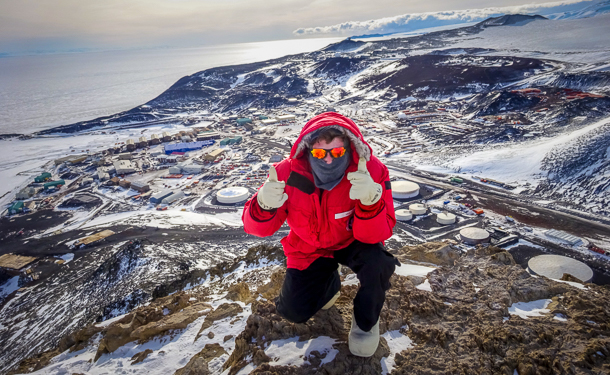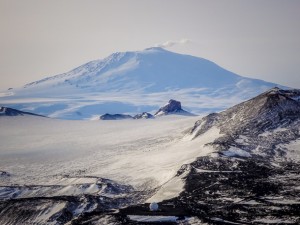
“Cold, windy and always light…” Eric King says of his temporary home in Antarctica, “as well as beautiful, mysterious, humbling and inspiring.”
For King, a 2014 environmental sustainability graduate of Eastern Mennonite University, the opportunity to spend several months of the austral summer working at this globally renowned site of scientific inquiry and international cooperation has been something of a dream come true.
Though he’s supporting scientists in their work and not conducting his own research, King has thoroughly enjoyed his experience in one of the harshest places on earth, where the environmental conditions are optimal for important and unique research in a number of fields: global climate change, ozone depletion, UV radiation, earth sciences, glaciology, astronomy, oceanic and atmospheric circulation, marine ecosystems and meteorite studies, among others.
Here, in his own words, straight from McMurdo Station, Eric King shares more:
The basics: where and what?

The National Science Foundation manages the United States Antarctic Program (USAP), the national program of research on the southernmost continent. There are three year-round U.S. research stations: McMurdo Station, where I am located, is the largest research station on the continent and is located on Ross Island by the Ross Ice Shelf. Amundsen-Scott South Pole Station is located at 90° south, about 900 miles south of McMurdo, and Palmer Station is located on Anvers Island, near the Antarctic Peninsula.
My job is not glamorous. However, it is still enjoyable and I love my co-workers. As a ‘steward,’ I work 57 hours per week, five days in the galley as a dining attendant, doing anything from food preparation to dishwashing, and one day on a janitorial team. [The 54-hour, six-day work week is standard for all at McMurdo; Eric’s specific job requires three extra hours.] I also recently began working as a barista in the coffee house two to four nights a month and will start volunteer shuttle driving soon.
My experience of the McMurdo community so far has been that everyone is generally very friendly and subscribes to very transient lifestyles. There is a great sense of unity and mutual respect among and between all of the departments as each one plays an important role in our shared purpose.
[Editor’s note: Here Eric echoes a statement made in the fascinating 102-page Participant Guide published by the National Science Foundation that details most aspects of life at McMurdo, including work ethic: “The objective is to support science, maintain the station, and see to the well-being of all station personnel. All are expected to work as much as necessary in attaining this objective.”]
Favorite moments
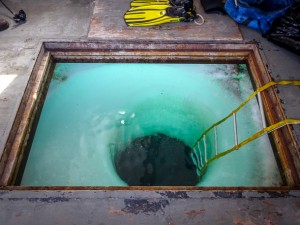
We are told not to expect a “boondoggle” [wasted time] when a support contractor gets the opportunity to assist a scientific endeavor. I was ecstatic when I returned from break one morning and my supervisor told me to be at the dive locker with my extreme cold weather gear and a packed lunch in half an hour.
I accompanied five biologists 15 miles off-station, where I tended one of their dives under the sea ice to collect sea spiders through which they are studying the phenomenon of polar gigantism. It was exhilarating to witness and participate in a small piece of the research that is the reason for the whole program’s existence.
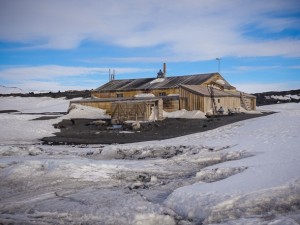
Another profound experience was a recreational trip north of McMurdo to Scott’s Hut, the base of the British Antarctic Expedition of 1910-1913 (also known as the Terra Nova Expedition) at Cape Evans. The hut and its contents were left almost exactly as it was over 100 years ago and naturally preserved by the conditions and aided by the efforts of the New Zealand Antarctic Heritage Trust. With human activity in Antarctica as limited as it is even today due to the harshness of the environment, it’s almost unbelievable that such early exploration took place. It was and is extremely humbling to know that my being in that hut on this continent in general is ultimately linked back to the work of the men who lived there, many of whom never made it home.
Living in a desert: challenges
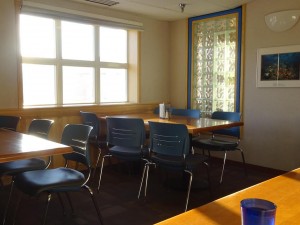
Being a desert, Antarctica is extremely dry, the driest place on Earth. For my first few days here, I felt perpetually thirsty, and my nose consistently bled trace amounts for the first few weeks. The only symptom of the climate that I continue to suffer is the severe dryness of my hands, a result of the unfortunate combination of the environment and the excessive expectation regarding food handling and hand-washing in an isolated population.
Another constant challenge has been maintaining a healthy circadian rhythm. Since it is daylight 24 hours a day during the Antarctic austral summer, there are work shifts around the clock. The majority of my days begin at either 3or 5a.m., and the perpetual sunlight coupled with ongoing human activity makes it difficult to go to bed at a responsible time. Similarly, there are no windows in my room, and until very recently, both of my roommates were on the ‘night’ shift, and the quiet and darkness make it hard not to sleep during the day.
Prepared by EMU experiences
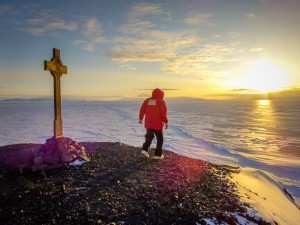
My 2012 cross-cultural to New Zealand instilled my desire to gain an intimate understanding of my planet, which now finds me in one of if not the most extreme and exclusive part of it.
The summer of my junior year, I participated in a Research Experience for Undergraduates (REU) funded by the National Science Foundation at West Virginia University, so I was eager to help support and get exposure to the world-class science that the NSF does here in Antarctica.
More specifically, I was an environmental sustainability major, so the prominence of climate research and NSF’s high level of commitment to environmental conservation under the Antarctic Treaty here were of particular interest. I am even involved in the young yet already successful McMurdo Green Team, a volunteer committee that facilitates the suggestion and implementation of ways to improve McMurdo’s environmental standard.
Finally, it was largely my four years of working in the EMU dining hall [Pioneer Caterers] that gave me the experience to get this job so a shout-out to dining hall director Bruce Emmerson, manager Ramona Lantz, head chef Monica Becks, and all of my past co-workers!
What’s next?
Before I was offered a contract by the USAP, I was set to go to the Dominican Republic through Vine & Fig (formerly New Community Project) — the non-profit organization and intentional community in Harrisonburg that I lived and worked in for 10.5 months — to do seed banking and other sustainable agriculture and food justice projects. That opportunity may still be available when I return. I am also considering a return to EMU to study at the Center for Justice and Peacebuilding.
